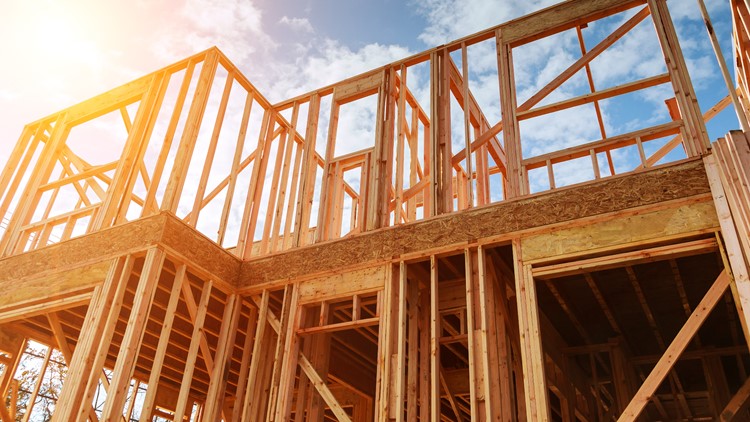SACRAMENTO, Calif. — This story was originally published by CalMatters.
It’s difficult for housing advocates to criticize Gov. Gavin Newsom because he’s done more to boost production than any other governor in recent memory — but that’s mostly because the bar is so low.
Measured against the goal he set for himself, Newsom’s record is less impressive. Just 13% of the 3.5 million homes he campaigned on building have been permitted, let alone built. He’s walked back the goal many times, settling on a new target earlier this year: Cities need to have planned a combined 2.5 million homes by 2030. So, a million fewer homes planned for, not built, and over a longer time frame.
Newsom can point to some accomplishments: He signed bills that capped big rent hikes statewide, legalized duplexes and fourplexes on most developable land and unlocked millions of potential apartments on empty strip malls. He sheltered tens of thousands of people experiencing homelessness amid a generational pandemic and dedicated more dollars to housing and homelessness than ever before.
But as he finalizes his first term and coasts into the second, Newsom finds himself mired in an even deeper housing and homelessness crisis than the one he inherited.
Running for governor in 2017, then-Lt. Gov. Newsom pledged to spur a never-before-seen tsunami of homebuilding in California to bridge the gap between the growing population and shrinking stock of housing driving the affordability crisis.
“As Governor, I will lead the effort to develop the 3.5 million new housing units we need by 2025 because our solutions must be as bold as the problem is big,” Newsom wrote on Medium.
The goal was true to character: big, hairy and audacious. It would have required building an average of 500,000 homes a year in a state that has only surpassed the 300,000 mark twice in more than 50 years.
Newsom didn’t get even close.
In the nearly four years since he took office, California cities are projected to have permitted a total of about 452,000 homes — less than he pledged he’d build in one year alone, according to local data collected by the Construction Industry Research Board.
When asked about his shortcomings at a recent press conference, Newsom wrote off his original goal as he has many times before, by paraphrasing Michelangelo.
“The biggest risk in life, however one defines risk, is not that we aim too high and miss it. It’s that we aim too low and reach it,” Newsom said. “It was always a stretch goal.”
Housing advocates acknowledge that policy change is by nature slow and incremental, and like many other proposals, long-term housing goals took a backseat to the COVID-19 pandemic.
But the reality on the ground — that there aren’t enough houses for everyone and the ones that exist are hideously expensive — continues to exasperate Californians who repeatedly rank housing and homelessness among their top concerns.
State Sen. Brian Dahle, the Republican candidate for governor, and other state Republicans have routinely attacked Newsom’s record on housing, including calling for a special session on homelessness.
“We need government to treat this the way we treat a natural disaster, because that’s how it’s impacting people’s lives,” said Chione Lucina Muñoz Flegal, executive director of Housing California, a housing advocacy organization. “And that’s not what we see happening.”
A Marshall Plan for housing?
Housing policy advocates described Newsom’s stated goal of 3.5 million new homes in four years the same way he has: aspirational. They say that’s because the state doesn’t build housing in California — private developers do, with the approval of local governments. So what really grabbed advocates’ attention was the “Marshall Plan for affordable housing” Newsom pledged to launch during his inaugural speech, recalling the multi-billion dollar program to rebuild Western Europe following World War II.
“As much as the number was important, the idea of building a streamlined process of building, that was amazing, because that’s really the challenge of California,” said Dan Dunmoyer, president of the California Building Industry Association. He said that dream remains elusive.
California has some of the highest housing costs in the nation because of how little “marshaling” there is, Dunmoyer said. Land costs are prohibitive, and zoning rules limit much of what can be built. Housing must get approved at the local level, which has ample opportunity for community input. Those communities can then block unpopular projects, such as multi-family or affordable housing. Another culprit: impact fees cities charge to fund infrastructure that can exceed $150,000 a home, some of the highest in the nation.
The closest Newsom may have gotten to bulldozing those barriers is Project Homekey. After COVID-19 hit, the administration scrambled to turn 94 hotels and motels into more than 6,000 shelter units for people experiencing homelesnsess, which would later become permanent homes, within record-setting months. The projects bypassed local land use rules and a marquee environmental law often blamed for slowing or killing controversial projects. The state has since expanded the $800 million project with more than $2.75 billion in new funding.
Newsom signed more than a dozen bills allowing housing types that met certain conditions to skip lengthy approval processes at the local level. Two are expected to have the biggest impact: one which legalized duplexes and fourplexes on the two-thirds of developable land in California previously zoned for single-family homes, and another that allows apartments on land previously allotted for retail centers, parking lots and offices along arterial roads.
While a zoning change doesn’t build housing, it’s a first step to making it legal. Combined, the two laws could open up previously blocked space for more than 2 million housing units.
“The effect of legislation is often hard to prove, because it’s only one factor of many in the development process,” said Louis Mirante, vice president of public policy at the Bay Area Council. “To stop a project, you only need one red light. But to make a project go, you need at least 100 green lights. A lot of the legislation the governor has been signing has been those green lights.”
But yellow and red lights abound, including rising interest rates and prohibitive material costs. While it took political courage to sign a controversial measure like the one streamlining duplex and fourplex construction, Newsom remained largely quiet on those bills until they reached the finish line, and hasn’t championed a more sweeping production policy proposal on his own.
“He can step in and resolve the problems if he really wanted to prioritize the issue,” said Chris Martin, policy director at Housing California. “He has the power to do it but politically, it’s challenging. He’s going to have to make some uncomfortable decisions.”
Moving the goalposts
While Newsom has repeatedly called the 3.5 million goal taken from a 2016 McKinsey study a moonshot, he has put his weight behind another number: 2.5 million. That’s how many homes the Legislature has mandated California cities to plan for by 2030, and Newsom’s team is making sure they do.
“Before we can reach our stretch goals, before you can reach the moon, you’ve got to get off the launch pad,” said Jason Elliott, Newsom’s senior counselor on housing and homelessness.
The planning law has been on the books for decades, but it wasn’t until 2017 that the state Legislature gave the process teeth by creating standards and penalties cities must abide by. The plans for the housing that those standards and penalties apply to weren’t even due for most cities until this year. And the deadlines are different for different regions. It’s a slow process.
Cities now have to zone for more than double the housing they did in previous years, and it has to be on sites where housing could actually be built. And if they don’t do it, they risk losing affordable housing dollars or even forgoing housing approval decisions.
But having laws on the books — even if they feature new penalties — doesn’t mean anything unless someone is there to enforce them.
To that end, Newsom staffed up a $4.65 million accountability and enforcement unit within the housing department, with reinforcements at the state’s Justice Department. Cities seem to be paying heed, but it’s all fun and games until actual homes get built.
“For many years in California, the Regional Housing Needs (Allocation) process was an afterthought at best,” Elliott said. “It was not taken seriously because there were largely no consequences for local governments failing to meet their responsibilities. And that’s not ancient history, but through a very concerted effort by this governor and the administration in partnership with the Legislature, RHNA is now very serious. And I think communities are taking it seriously.”
But planning isn’t building, and a recurring complaint about the process from cities is that while it requires a lot of affordable housing to be planned for — 1 million of the 2.5 million units must be affordable to the lowest earners — the state doesn’t provide nearly enough tax credits and other subsidies to build it.
“We’re funding a quarter of that, at best,” said Paavo Monkkonen, associate professor of urban planning at UCLA’s Luskin School of Public Affairs. “So that’s an interesting conundrum, where their own goal is unattainable. And there’s not really a Manhattan Project to make that happen.”
With the Legislature, Newsom has dedicated unprecedented dollars to affordable housing, including $10.3 billion in 2021. Funding the current affordable housing need alone, however, would require nearly $18 billion a year over a decade, according to a recent estimate from Housing California and California Housing Partnership. And there is no long-term source of funding for housing in California. As budget projections for next year sour, affordable housing advocates worry those funds might dry up.
“In these years of good budget outlook, the administration has done a really good job,” said Marina Wiant, vice president of government affairs at the California Housing Consortium, a non-partisan housing advocacy organization. “It’s going to be interesting to see what they do when they have to make tough budget choices.”
CALmatters.org is a nonprofit, nonpartisan media venture explaining California policies and politics
WATCH MORE: Lack of progress in providing Sacramento homeless shelters



